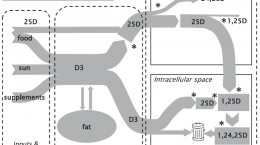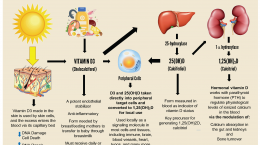Published on June 25, 2021
Each form of vitamin D, not just the hormonal form, is necessary for optimal health
 There is a common misconception that the only ‘active’ form of vitamin D, and the only one that really matters to our health, is the hormonal form 1,25- dihydroxyvitamin D [1,25(OH)2D], or calcitriol.
There is a common misconception that the only ‘active’ form of vitamin D, and the only one that really matters to our health, is the hormonal form 1,25- dihydroxyvitamin D [1,25(OH)2D], or calcitriol.
However, this is certainly not true!
Vitamin D Exists as Several Forms in the Body
“Vitamin D” is a term that refers to several compounds. Many people refer to 1,25-dihydroxyvitamin D [1,25(OH)2D] or calcitriol, which is made by the kidneys and circulated in the blood, as the active form of vitamin D. While it is true that it is the hormonal form of vitamin D, it is not the only form that has specific effects within the body.
In this post, we will be discussing the three specific forms of vitamin D illustrated in the diagram below, and several specifics of each: Vitamin D3 (Cholecalciferol), 25-hydroxyvitamin D [25(OH)D or Calcifediol], and 1,25-dihydroxyvitamin D [1,25(OH)2D or Calcitriol].
Vitamin D3 – The Vitamin D We Take or Make
As humans, our major source of vitamin D3 is the sun. UVB rays in sunshine convert a precursor in the skin to vitamin D3 or cholecalciferol, and the amount of vitamin D produced depends on several factors, including the UV Index, time spent in the sun, amount of skin exposed, and the amount of melanin in the skin (which is produced by the sun to help protect the skin). However, when we do not get enough sunlight or we are unable to make vitamin D because of the angle of the sun, we must get vitamin D from artificial UVB, our diet, or supplements. Vitamin D3 is found in a few dietary sources, such as fatty fish.
What has not been appreciated until relatively recently is that in addition to being delivered to the liver for conversion to 25(OH)D, vitamin D3 is also delivered directly to all tissues of the body. Many of these tissues, such as breast, colon, prostate, and brain, can convert vitamin D to its other forms within the tissue. It is through this process that vitamin D can help enable the cells to fight against infections, disease, and autoimmune disorders.
Important Points about Vitamin D3 (Cholecalciferol)
- Skin makes vitamin D3, which enters the blood and is also used by the skin
- Keratinocytes, which make up over 90% of the outermost layer of skin, cannot rely on the blood for its supply of vitamin D and must synthesize their own vitamin D3 directly from sun exposure, or receive it by topical application
- Vitamin D3 produced in the skin can decrease DNA damage in the skin cells and facilitate DNA repair directly upon any UV damage, and help prevent cell death
- The most common form found in supplements
- Found in foods such as salmon, eggs, and dairy and fortified foods such as milk and margarine (although usually as vitamin D2 in fortified foods)
- Form that is transferred from mom to baby through breastmilk when mom’s vitamin D3 levels are high enough
- Half-life of approximately 24 hours – must receive it on a daily or semi-daily basis (see below)
- Majority is converted in the liver by hydroxylation to make 25-hydroxyvitamin D; some taken directly into cells for conversion and use, including breast, colon, prostate, and brain, to fight local infection and inflammation
- Is the most potent form of vitamin D for endothelial stability (inhibits permeability of the endothelial and vascular lining, and reverses inflammation, results in reduced leakage into surrounding tissues)
- 1000 times more potent than 25(OH)D
10 times more potent than 1,25D
Vitamin D3 Gets Converted to 25(OH) Vitamin D
As mentioned above, the majority of vitamin D3 goes to the liver for its first conversion process, 25-hydroxylation. This process converts vitamin D3 into 25-hydroxyvitamin D [or 25(OH)D], which is this form of vitamin D that is measured in the blood as an indication of an individual’s overall vitamin D status.
Important Points about 25-hydroxyvitamin D or 25(OH)D (Calcifediol)
- A very small amount can be ingested from animal foods
- Taken directly into certain cells (such as immune cells) and converted to 1,25-dihydroxyvitamin D; conversion of 25(OH)D within the cells to 1,25(OH)2D is used locally by those cells or neighboring cells as a signaling molecule
- Controls activation of T cells during immune response
- Measured in the blood to determine status of vitamin D within the body
- Half-life of 2-3 weeks
- Used as a signaling molecule in most cells and tissues, including immune, brain, blood vessels, heart, lung, and many others
- Can be given during a severe immune attack, when the need for vitamin D is increased, as with COVID-19 patients. Waiting for the body to convert vitamin D3 to 25(OH)D3 may not be suitable for those experiencing such conditions and who are vitamin D deficient, therefore 25(OH)D3 itself can be given in order to raise the blood levels more quickly.
1,25(OH)2D – the Hormonal Form of Vitamin D
Conversion of 25(OH)D into what is commonly referred to (and mistakenly labeled as) the “active” or hormonal form of vitamin D, 1,25(OH)2D (or 1,25D), is done mostly in the kidneys as part of vitamin D’s function within the endocrine system. In this case, the process is highly regulated by the parathyroid through what is known as a “negative feedback loop.”
The hormonal function of vitamin D is as the main regulator of calcium absorption in the intestines – when calcium levels are low, the parathyroid initiates an increase in the rate of conversion of 25(OH)D to 1,25D, which then increases the amount of calcium that is absorbed. When calcium levels are high, conversion of vitamin D into its hormonal form is decreased. Learn more about the relationship between vitamin D and the parathyroid here.
The ability to perform this conversion is also available within cells outside of the kidneys, as part of vitamin D’s function within the paracrine system. In this situation, such as with an immune response, a cell has a specific need for 1,25D. It will then pull vitamin D3 or 25(OH)D into the cell and convert it into 1,25D, where it can act directly within the cell and neighboring cells as a signaling molecule in order to produce the desired function. More can be learned about the endocrine vs. the paracrine functions of vitamin D here.
Important Points about 1,25-dihydroxyvitamin D or 1,25(OH)2D (Calcitriol)
- Hormonal form of vitamin D that circulates in the blood, often referred to the “active” form of vitamin D
- Uptake and conversion of 25(OH)D within the kidneys by hydroxylation to 1,25(OH)D2D for endocrine use, controlled by PTH
- Regulates calcium absorption within the intestines, important to bone health
- Increases bone turnover to increase blood levels of calcium
- Half-life of four hours
What is a Half-Life?
Important to understanding how vitamin D is processed in your body, and why it is important to receive vitamin D3 on a regular basis, is the concept of a half-life. The half-life of a compound is a time measurement of how long that compound remains in the body. It is the amount of time in which half of the substance is gone. When that amount of time passes again, another half of what remained previously is gone, and it continues in an exponential nature. The graph looks like this:

Source: Chemistry LibreTexts
Vitamin D3 has a half-life in the autocrine system of roughly 24 hours, so in order for it to have a meaningful impact on cellular functions, you need a new supply of it every day. This understanding means that frequency of dosing matters when testing for disease reduction and immune control – which can help explain why large monthly or quarterly doses that may be effective for bone health are not likely to show positive results for disease reduction. For disease prevention and treatment, daily dosing (food, sun, and supplement) is very important.
The half-life of 25(OH)D is much longer, 2-3 weeks, which is why it is a more reliable way to measure individual vitamin D status. Lastly, the half-life of 1,25D is only four hours, making testing accurate much more difficult.
Measure Your Level of Vitamin D Today!
 Having and maintaining healthy vitamin D levels and other nutrient levels can help improve your health now and for your future. Choose which to measure, such as your vitamin D, omega-3s, and essential minerals including magnesium and zinc, by creating your custom home test kit today. Take steps to improve the status of each of these measurements to benefit your overall health. You can also track your own intakes, symptoms and results to see what works best for YOU.
Having and maintaining healthy vitamin D levels and other nutrient levels can help improve your health now and for your future. Choose which to measure, such as your vitamin D, omega-3s, and essential minerals including magnesium and zinc, by creating your custom home test kit today. Take steps to improve the status of each of these measurements to benefit your overall health. You can also track your own intakes, symptoms and results to see what works best for YOU.
Enroll and test your levels today, learn what steps to take to improve your status of vitamin D (see below) and other nutrients and blood markers, and take action! By enrolling in the GrassrootsHealth projects, you are not only contributing valuable information to everyone, you are also gaining knowledge about how you could improve your own health through measuring and tracking your nutrient status, and educating yourself on how to improve it.






